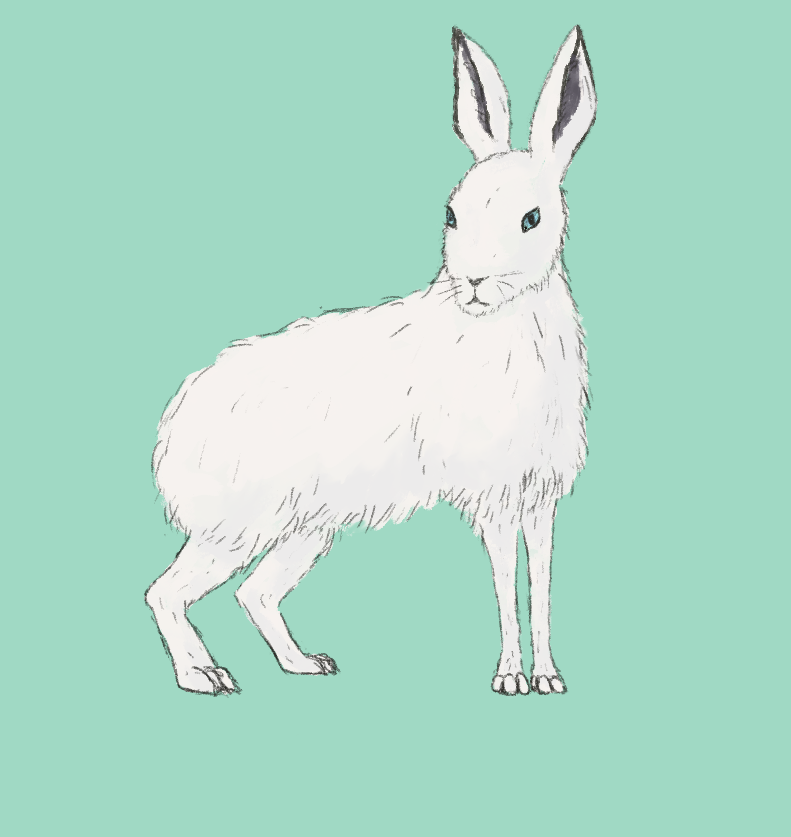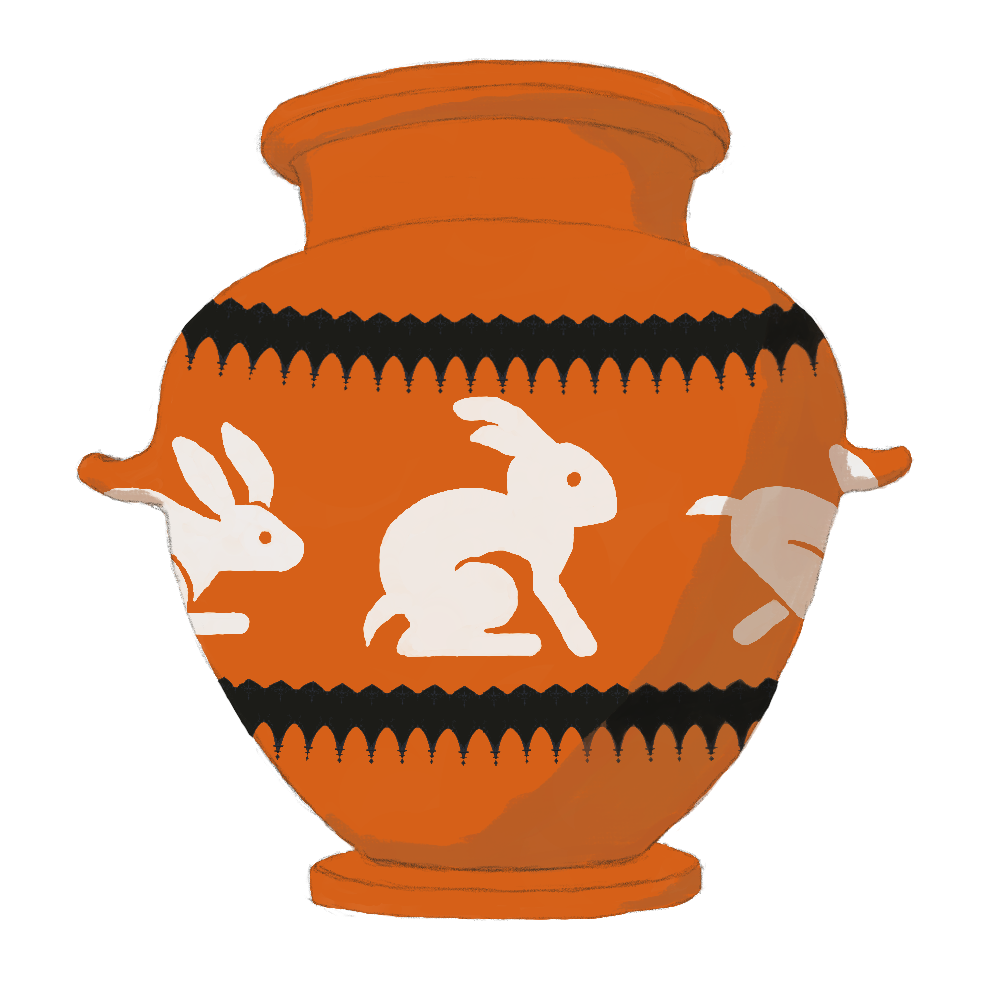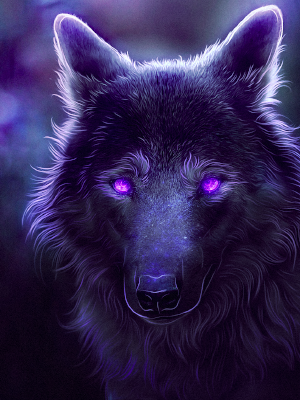Naef Hare
High on the western slopes of the Tolach Naelath mountains, an abundance of large white hares browse amongst the low shrubs and grasses. Usually spotted alone, they blend well against the occasional patches of melting snow that still remain in spring. Icy blue eyes scan their surroundings as they search for their favourite snack, blue mountain vetch.
Though other populations of these hares exist in some parts of the Kynfesan mountain range, it is only here in the Tolach Naelath that they are found in such abundance. They have therefore become something of a mascot for the mountain range and the local population treat them with care and incorporate their image into many of their crafts.
Although no one is quite sure how the relationship between Naef Hares and blue mountain vetch works, the local population is well aware that a low number of hares means more magical instability in the region. They are Researchers therefore suspect that only the right density of both hares and vetch can successfully stabilises the effects of a magical boundary zone in a region with such a relatively high level of environmental magic. How to confirm this theory without disturbing the system or the people of the region is still a debated subject.
Appearance
Despite living through bitterly cold winters, Naef hares are no smaller than their lowland counterparts. For much of the year they are characterised by a thick blanket of snow-white fur and when huddled out of the wind are positively round balls of fluff. Their powerful long legs jut out from underneath though when standing up, enabling them to get through brush and snow with ease. Black-rimmed ears give them a rather dapper appearance even as it helps keep the sensitive tissue just a little warmer. In summer their coat thins out and fades to a soft brownish grey.
Unusually for hares, the iris of their eyes is a striking blue, although they show no signs of albinism and leverets are born with brown eyes. Researchers think the colour may be related to the hares' diet.
"Looks like a cloud on sticks, it does. You could spin that thing into cotton candy."
Habitat Range
The Naef Hares seem ecologically so strongly tied to the boundary zone by their diet that researchers are considering whether the most effective method to map said boundary zone would be to map Naef Hare forms in spring.
Unfortunately for the researchers the hares are highly elusive in breeding season and the local population is unwilling to share what they know as they are worried about the disturbance this might cause to the hare population.
The Tolach Naelath mountain range has three main magical aura's; one for the western slopes, eastern slopes and heights above the vegetation line respectively. Between these zones is a boundary area, which in areas with high magic levels can cause some magical instability. Naef Hares roam the boundary area between that of the lower western slopes and that of its peaks and seemingly thrive there. Indeed despite the Tolach Naelath possessing a high level of magic for a "mundane" area, this boundary zone has been recorded to be remarkably stable.
The magical aura's are not static things but shift with the seasons with the aura of the peaks pushing its way down the slopes in winter and receding again when temperatures rise. The hares are known to migrate along with it. Despite their abundance, Naef Hares are not commonly seen by folk; they appear to be experts at noticing one's approach and hiding in time to avoid notice. Yet in winter they are easiest to find - perhaps they are less cautious in their camouflaged winter coats and expect that their most dangerous foes will have moved further down rather than staying in the snow.
Diet
Naef Hares primarily subsist on blue mountain vetch, a legume plant that only grows above the tree line on the western slopes of the Tolach Naelath. They will eat young shoots of these plants but particularly seek the deep blue flowers and young seed pods. Anyone lucky enough to spot a hare eating will have seen them munching on these with the appearance of great pleasure.
Importantly for both species, the Naef Hare population is also an item in the diet of other species (primarily foxes, wolves and birds) which helps the plant maintain a stable population despite grazing pressure. This, in turn, provides the hares with a reliable food source rather than experiencing crashes and booms.
Through the consumption of the fruits and seed pods, some inherent magic of the Naef Hare also allows it to absorb the magic of the plant. Blue mountain vetch has a stabilising effect on magic in an uneasy state and the hares contribute to this effect in the area. They spread the effect around as they search for vetch blooms and keep the aura's stable in winter too, while the effect of vetch is lessened by the plants' dormant state.
Adult Naef Hares have heightened senses and their eyes, once fully blue, are extremely keen. They're also a little better at hiding than is entirely natural, especially in the summer when its light coat should not be too difficult to spot.
Omnivorous
The long cold winters above the tree are are tough on Naef Hares as the vetch is largely buried beneath the snow and without young shoots. Solitary throughout much of the year, small groups of Naef Hares will be huddled together, preferably in very small caves. They survive on bark from shrubs and meat from any carcasses they can find. Although they aren't predators, they are surprisingly voracious hunters for meat in the winter. Many a cold fox has been disappointed when arriving at a carcass to find it stripped almost bare and no longer a hare in sight.Guardians of the Mountains?
"In my grandmother's grandmother's time there was a year of extreme cold and a winter that seemed to never end. Down in the valleys crops could not start growing, our livestock died and our stores ran out. People huddled together, inviting the cows and sheep inside both for warmth and to keep them alive. The only fires lit were those indoors, our spells failed more and more often. It seemed as if spring would never arrive and animals in the forest starved. If we were lucky, one could find a carcass and take it home, but often we had to take to hunting further afield than usual. Even the white hares were snared to still the crying of babes at home. But eventually spring did come and even the blazing summer did in the end. Plants came back and flowers covered the mountain slopes as if to make up for the bad winter. But not all was well. Crops still failed for our spells would not take. Young livestock died in the night as protections failed. Most of the wild animals seemed to have recovered from the winter, as the tough wild animals do. Yet the Naef Hares could not be found. Our village spotted not a single one up on the slopes. It was not until late autumn that a young lad, chasing a wayward goat who would not heed the luring song, spotted one. The lad stopped and he and the hare watched each other carefully. The lad retreated, leaving the hare to browse in peace though it now took him a long time to find his goat. The next time he had to chase a goat up there, the slope was dotted with little leverets, watching him. And for the first time in months, his luring spell caught the goat. That is how we know that the white hares guard the magic of the mountain folk. Though they are rarely seen by us, they are watching and wish us well."
Blue Mountain Vetch
Plant typeHerbaceous legume Geographic distrbution
Western slopes of Tolach Naelath Alternative names
Hare's leaf, afonel Blue mountain vetch most often appears as a thick tuffet of sage green leaves sprouts out of the ground and between rocky crags. Similar to other vetch species, they have pinnate leaves. Outside of flowering season they have an unassuming appearance. But in flowering season they bear masses of large deep blue flowers which are considered extremely pretty and a characteristic sight of the Tolach Naelath. Blue mountain vetch can be found throughout the entire boundary range, all the way very top of the vegetation line down to the tree line where the outer edge of the boundary zone lies in winter. It has a preference for sandy, fairly barren soil and avoids very lime rich areas. Yet it is a seemingly fussy sort of plant, as blue mountain vetch will only produce flowers and seed pods whilst inside the boundary zone between the magical aura's of the lower western slopes and the peaks. As a result they don't have a single productive season with plants lower down blooming in autumn and those higher up during late spring and high summer as the boundary zone retreats upwards. Seed dispersal is assisted by the Naef Hares as well. Mature seeds will cling to their fur once they have burst out of the ripe pods. The combination of the Naef Hare's grazing of blue mountain vetch and its assistance with seed dispersal throughout the entire boundary zone keeps the plant population at a healthy and relatively stable density. Despite its relatively modest appearance and size, blue mountain vetch is a uniquely magical species. At the right density it helps stabilise the effects of a boundary zone between magical aura's. It is also unusual in its ability to pass its magic along to its grazer, although only the Naef Hare seems able to make use of it through some inherent magic of their own.






A wonderful symbiosis that you have described here and the little story at the end shows that the residents are also a third party to the symbiosis, even if they would not die immediately if the rabbits were no longer there.
Here are my Entries for the water continent Ulűri̋qi̋
Thank you! In truth, their magic didn't fail quite as badly as the folk tale makes out, but it makes for a good story. Spells do become unpredictable and therefore very unreliable in such a zone though, which when you're already in dire straights probably makes it feel as though nothing works. Living there would definitely be much harder and riskier without the hares.